Frontispiece by Theodore Von Holst of the 1831 edition of Frankenstein. The monster in this illustration, which Mary Shelley would no doubt have seen, is closer to the description in the text than the myriad shambling figures that came later.
It’s a recurrent feature of commissioned work that you sometimes find yourself illustrating novels or stories you might otherwise have never attempted. Spanish publisher Editorial Alma have just added a new edition of Mary Shelley’s Frankenstein to their series of illustrated classics, convenient timing with this year being the bicentenary of the book’s first publication. Last year I produced 33 illustrations for Alma’s collection of Poe stories, as well as 3 new illustrations for a small Lovecraft collection. For their edition of Frankenstein I’ve created 24 full-page pictures, one for each chapter. (I produced 25 in total, 24 for the chapters and one for the letters at the front, but the Spanish translation is arranged slightly differently so one of the drawings has been omitted.) In the past I’ve given little consideration to illustrating classic books, preferring to look for subjects which were less familiar. Frankenstein is a book that isn’t illustrated as much as some but Lynd Ward in 1934, and Berni Wrightson in 1977/78 both produced sufficiently exceptional sets of drawings for me to regard the novel as almost unassailable. Until last year, that is.
Frankenstein by Lynd Ward (1934).
Despite such formidable predecessors, I felt that with this book at least I might be able to offer something new using the blend of collage and drawing that I’ve been evolving recently. There was additional promise in that the story as it’s written is less familiar than the Poe stories, and much less familiar than its fellow horror classic, Dracula. People think they know Frankenstein but what they often know is the manglings the novel has received in various film and TV adaptations. The Ward and Wrightson illustrations stay close to the text, the latter being replete with period detail, and rendered in a style reminiscent of 19th-century wood engravings. Wrightson even copied two of Gustave Dore’s pictures from The Rime of the Ancient Mariner for the opening scenes on the ship, one of which went unused. But Wrightson’s drawings are closer still to Franklin Booth‘s pen-and-ink style which was also derived from wood engraving yet which achieves its effects in a different manner to the engraving process.
Frankenstein by Berni Wrightson (1977/78).
Even when artists follow the text of Frankenstein more closely than the screenplay adapters, personal tastes can’t help manifest themselves. So Ward’s drawings reflect the angular and stylised compositions of his “novels in woodcuts”, while Wrightson’s work still shows evidence of his earlier career as a comic artist. With my illustrations I wanted to reflect the artistic spirit that gave birth to the novel, namely Romanticism. Frankenstein is very much a Romantic tragedy with violent passions set against the overwhelming landscapes of the Swiss Alps, the Rhine valley and the Arctic seas. Three of the illustrations below allude to Caspar David Friedrich’s paintings, while many of the others have had their mundane cloudscapes exchanged for gloom and tumult.
I’ve said before that one of the things I enjoy about the collage technique is being able to use engravings and other graphics from the same period (give or take a few decades) as the story itself. The disadvantage of relying on pre-existing sources is that you’re always limited by the available material, so recently I’ve been pushing the technique further to achieve a hybrid style, something midway between the Ernst/Sätty engraving-collage technique and the very laborious, heavily-shaded pen-and-ink style I used when I was drawing comics. The approach isn’t so different to the one I used in my Lovecraft comics many of whose backgrounds and other details were copied from photographs. The difference is that where I used to spend several days working on a single panel (and two weeks working on a page) I can now create an entire picture in half the time. In these new illustrations I feel the hybrid style is working as I intended, allowing me greater freedom to create the picture I have in mind rather than a picture dictated by the source material. Without incorporating original figures and other drawn elements into the compositions it would have been difficult to illustrate a story with the same characters in so many scenes, a problem I encountered when I was illustrating Lewis Carroll’s Alice books and ran out of pictures of Victorian girls.
The full run of pictures follows below, including the one which was omitted from the print edition. All may be seen at a larger size here. Since the scenes aren’t always self-explanatory I’ve included fragments of text from each chapter.
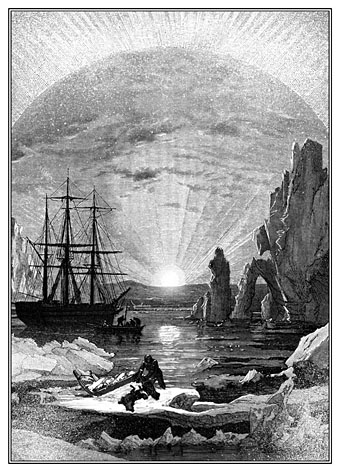
“In the morning, however, as soon as it was light, I went upon deck and found all the sailors busy on one side of the vessel, apparently talking to someone in the sea. It was, in fact, a sledge, like that we had seen before, which had drifted towards us in the night on a large fragment of ice.”
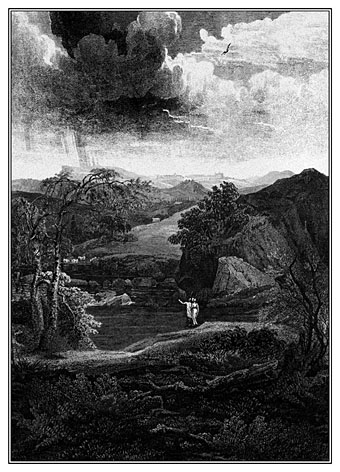
“During one of their walks a poor cot in the foldings of a vale attracted their notice as being singularly disconsolate, while the number of half-clothed children gathered about it spoke of penury in its worst shape.”
This one was omitted from the Alma edition. No loss, really, since the scene doesn’t add much to the story.
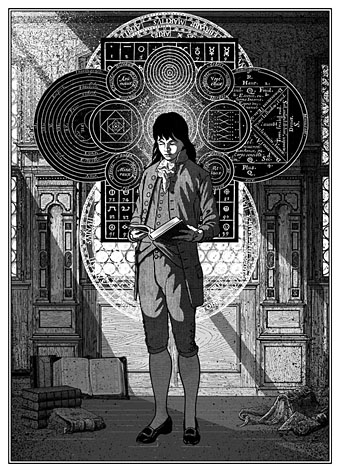
“When I returned home my first care was to procure the whole works of this author, and afterwards of Paracelsus and Albertus Magnus. I read and studied the wild fancies of these writers with delight; they appeared to me treasures known to few besides myself.”
The diagrams here are taken from some of the books the young Victor Frankenstein is reading. There’s an allusion to this in the magic square on the wall in the back of Theodore Von Holst’s frontispiece, the square being the kind of thing seen in books like this one by Cornelius Agrippa, one of the occult philosophers mentioned in the novel.
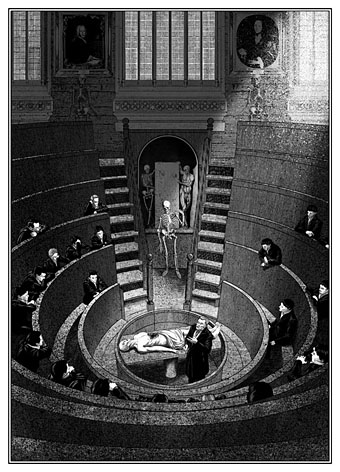
“Partly from curiosity and partly from idleness, I went into the lecturing room, which M. Waldman entered shortly after. This professor was very unlike his colleague.”
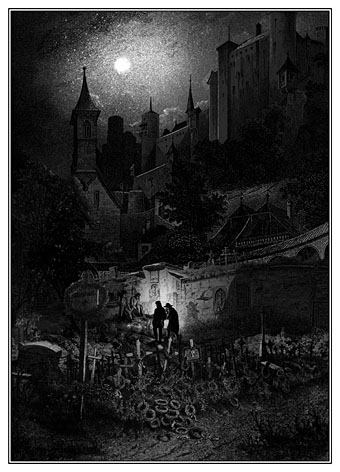
“To examine the causes of life, we must first have recourse to death. I became acquainted with the science of anatomy, but this was not sufficient; I must also observe the natural decay and corruption of the human body.”
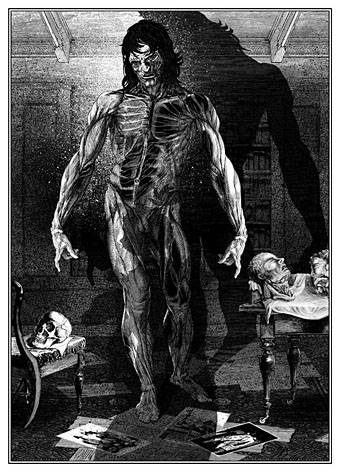
“How can I describe my emotions at this catastrophe, or how delineate the wretch whom with such infinite pains and care I had endeavoured to form? His limbs were in proportion, and I had selected his features as beautiful. Beautiful! Great God!”
My creature is an amalgam of several anatomical illustrations so it imitates in digital form the stereotypical view of the creature being pieced together from different bodies. This isn’t the process in the novel, however, where the descriptions of Frankenstein’s working methods remain vague.
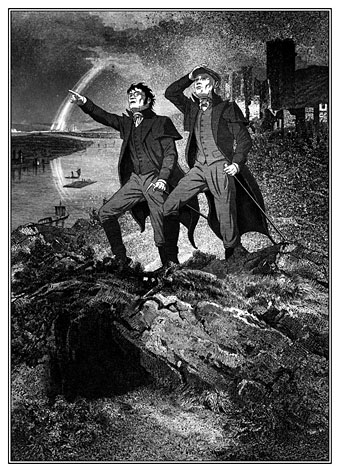
“We passed a fortnight in these perambulations: my health and spirits had long been restored, and they gained additional strength from the salubrious air I breathed, the natural incidents of our progress, and the conversation of my friend.”
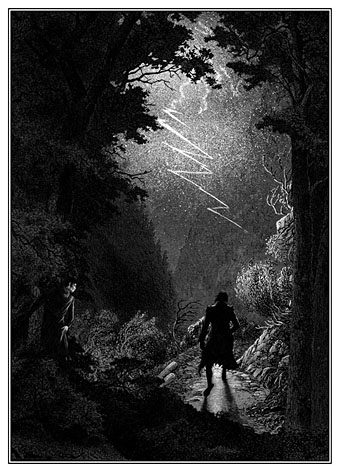
“A flash of lightning illuminated the object, and discovered its shape plainly to me; its gigantic stature, and the deformity of its aspect more hideous than belongs to humanity, instantly informed me that it was the wretch, the filthy daemon, to whom I had given life.”
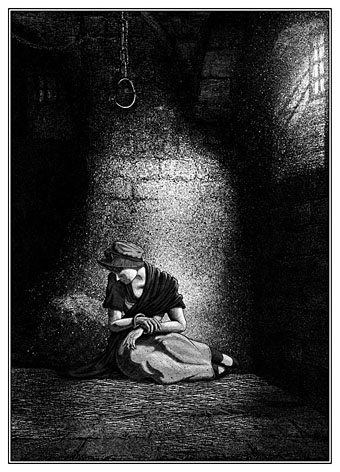
“The idea of this visit was torture to me, yet I could not refuse. We entered the gloomy prison chamber and beheld Justine sitting on some straw at the farther end.”
One of the subplots in the story is that of the serving girl wrongly accused of a murder perpetrated by the monster.
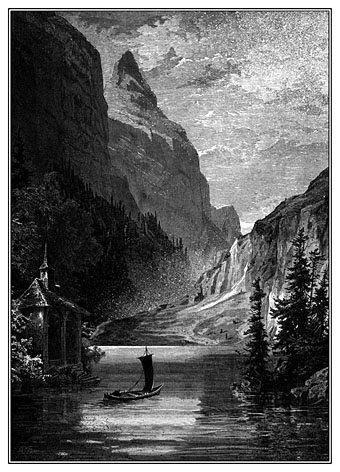
“Sometimes, with my sails set, I was carried by the wind; and sometimes, after rowing into the middle of the lake, I left the boat to pursue its own course and gave way to my own miserable reflections.”
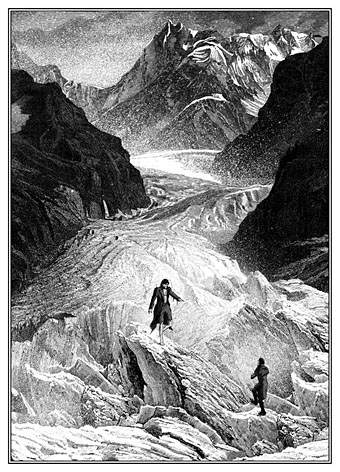
“I perceived, as the shape came nearer (sight tremendous and abhorred!) that it was the wretch whom I had created. I trembled with rage and horror, resolving to wait his approach and then close with him in mortal combat.”
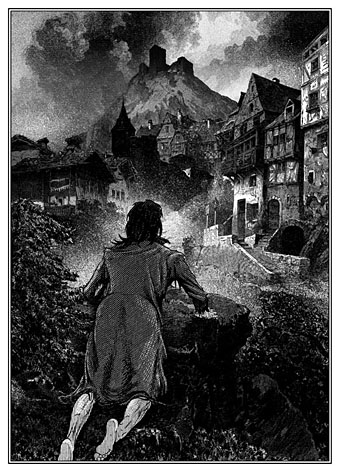
“I proceeded across the fields for several hours, until at sunset I arrived at a village. How miraculous did this appear!”
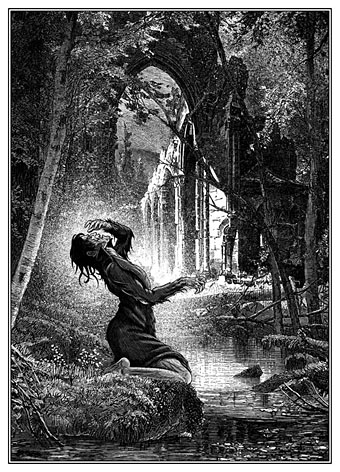
“I had admired the perfect forms of my cottagers—their grace, beauty, and delicate complexions; but how was I terrified when I viewed myself in a transparent pool!”
I added a ruined abbey to this scene as a nod to the many similar ruins in Caspar David Friedrich’s paintings.
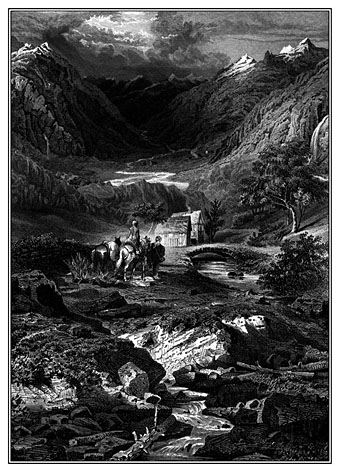
“It was a lady on horseback, accompanied by a country-man as a guide. The lady was dressed in a dark suit and covered with a thick black veil.”
Another subplot, and one which never survives the adaptations, concerns the group of Turkish refugees whose story instructs the monster in the injustices of the world. Almost all these landscapes were pieced together from very narrow strips of four or five different pictures.
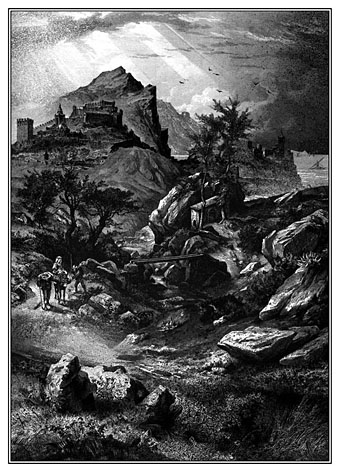
“Felix conducted the fugitives through France to Lyons and across Mont Cenis to Leghorn, where the merchant had decided to wait a favourable opportunity of passing into some part of the Turkish dominions.”
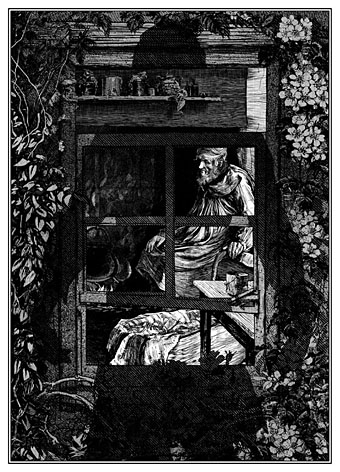
“At first his countenance was illuminated with pleasure, but as he continued, thoughtfulness and sadness succeeded; at length, laying aside the instrument, he sat absorbed in reflection.”
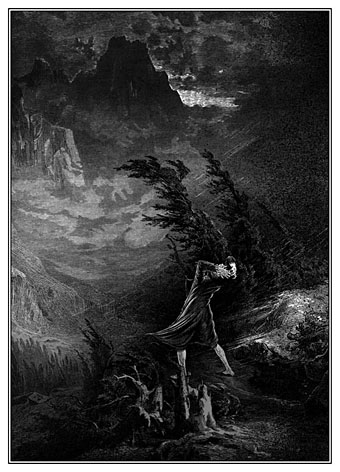
“When night came I quitted my retreat and wandered in the wood; and now, no longer restrained by the fear of discovery, I gave vent to my anguish in fearful howlings.”
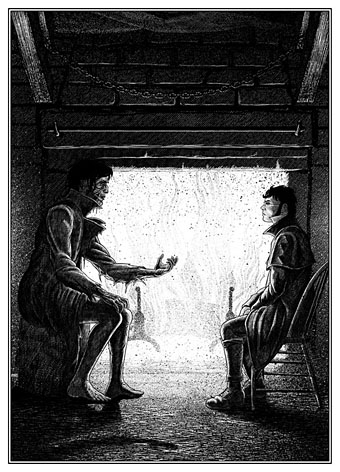
“The being finished speaking and fixed his looks upon me in the expectation of a reply. But I was bewildered, perplexed, and unable to arrange my ideas sufficiently to understand the full extent of his proposition.”
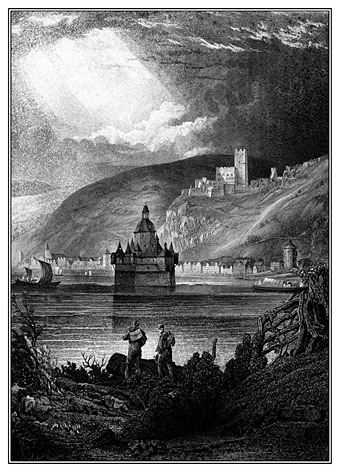
We had agreed to descend the Rhine in a boat from Strasbourg to Rotterdam, whence we might take shipping for London. During this voyage we passed many willowy islands and saw several beautiful towns.”
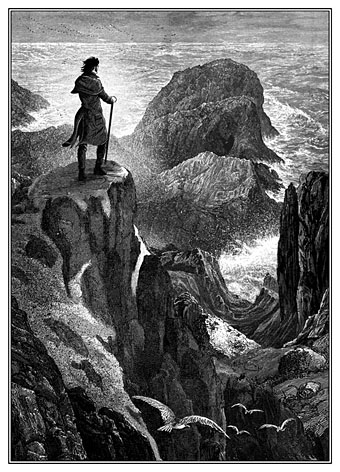
“In this retreat I devoted the morning to labour; but in the evening, when the weather permitted, I walked on the stony beach of the sea to listen to the waves as they roared and dashed at my feet. It was a monotonous yet ever-changing scene.”
As previewed a few days ago, this one alludes to Friedrich’s Wanderer above the Sea of Fog.
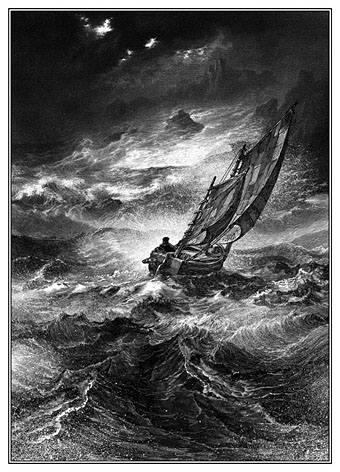
“Thus situated, my only resource was to drive before the wind. I confess that I felt a few sensations of terror. I had no compass with me and was so slenderly acquainted with the geography of this part of the world that the sun was of little benefit to me.”
Frankenstein in the skiff looks fairly seamless but it was pieced together from multiple fragments of waves taken from several seascape pictures. This was a tough one since the perspective is more of a problem with the sea, and I was relieved it worked so well.
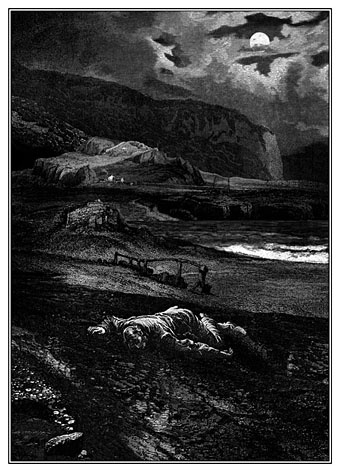
“As he was proceeding along the sands, he struck his foot against something and fell at his length on the ground. His companions came up to assist him, and by the light of their lantern they found that he had fallen on the body of a man, who was to all appearance dead.”
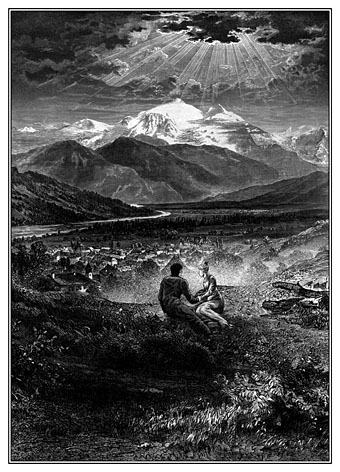
“She looked forward to our union with placid contentment, not unmingled with a little fear, which past misfortunes had impressed, that what now appeared certain and tangible happiness might soon dissipate into an airy dream and leave no trace but deep and everlasting regret.”
Another Friedrich reference, the pose of the figures being based on the couple in this painting.
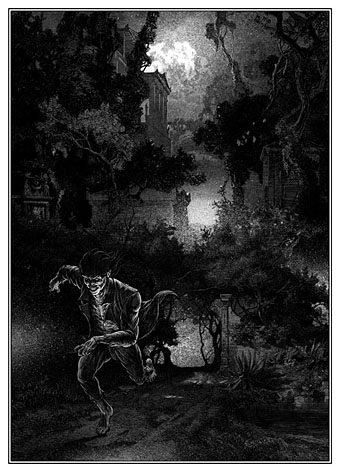
“I rushed towards the window, and drawing a pistol from my bosom, fired; but he eluded me, leaped from his station, and running with the swiftness of lightning, plunged into the lake.”
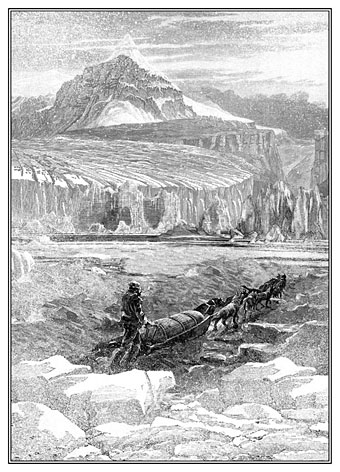
“Immense and rugged mountains of ice often barred up my passage, and I often heard the thunder of the ground sea, which threatened my destruction. But again the frost came and made the paths of the sea secure.”
Previously on { feuilleton }
• Narraciones extraordinarias by Edgar Allan Poe
• Lynd Ward’s Frankenstein
• Two Brides
• Berni Wrightson’s Frankenstein

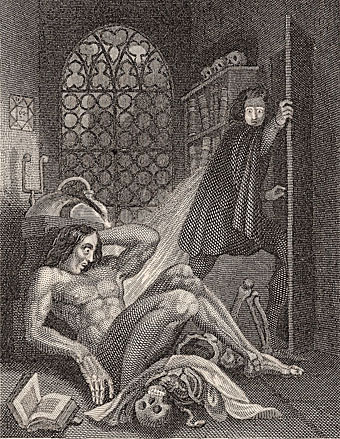
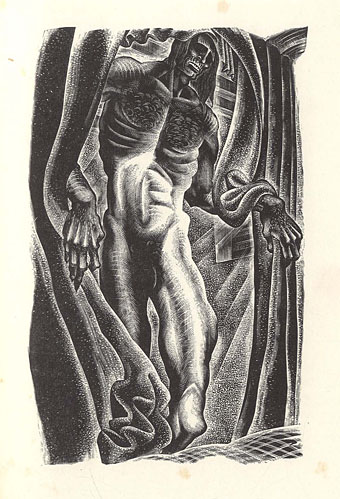
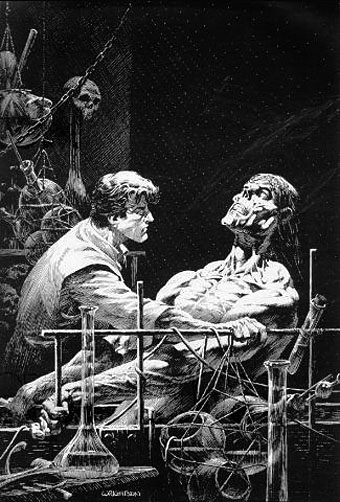
Well done–Romanticism regain’d.
There is pleasure in the pathless woods,
There is a rapture on the lonely shore,
There is society, where none intrudes,
By the deep sea, and music in its roar:
I love not man the less, but Nature more
–Byron, Childe Harold